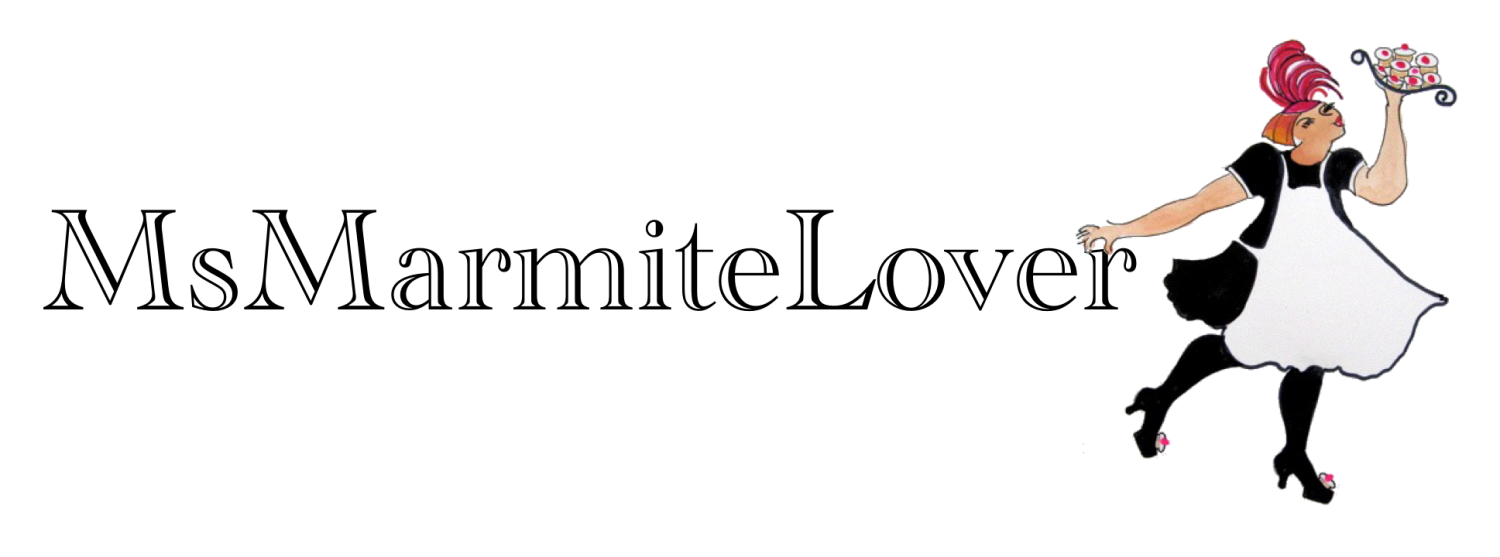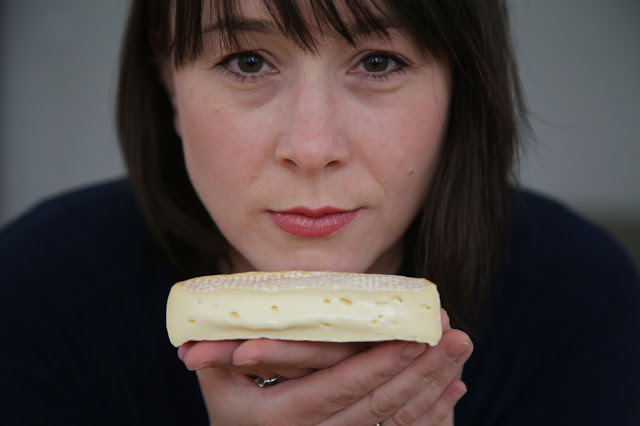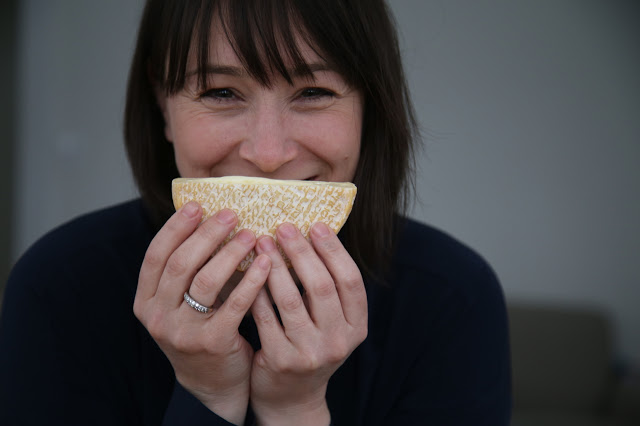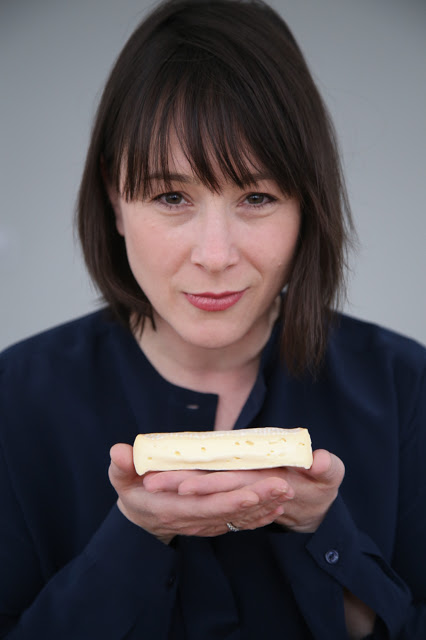my last trip to New York in 2011. We met in the lobby at the Ace Hotel and
immediately hit it off. Her particular speciality is cheese – she was the
fromager for high end restaurants in New York and created Casellula, a
ground-breaking cheese and wine restaurant. Tia pairs cheese with unusual
flavours, and creates things like cheese sushi.
life has changed drastically: she now lives in a light and airy house in Queens
with her husband Hristo Zisovski, the chef sommelier and wine buyer for a host of
top Manhattan restaurants, and they have a beautiful son, Sterio.
describe her forthcoming first book ‘The Art of the Cheese Plate’ (Rizzoli, September 2016):
I wanted this book to reflect the spirit that I have always brought to cheese: playful, sexy, whimsical, a little irreverent, but backed up by solid knowledge.
She added that she wanted the book:
To look really different from many other cheese books, which I think of as kind of visually lazy, you know, relying on the aesthetic cliché of county life: the distressed wood, the casually strewn antique knives, the rose-coloured romance of some Provencal farmhouse or something.
I arranged the entries by season and by “weight”, so we start out with lighter themes and visuals and end with darker, heavier, more aggressive themes and visuals as we progress through the flights in the book. I don’t state this anywhere in the book but that’s what I did. Again, I hope the reader gets the “feeling” of that. I don’t want or need to spell it out.
I wanted to make something that only
I could’ve made but that is ultimately totally user-friendly and relatable. I want this to be a joyful object for whoever owns it.
at her beautiful house in Queens with a couple of good bottles of wine and a
few cheeses and discussed motherhood, pregnancy, taste, politics, Western
medicine, the restaurant industry, sexism, well just about everything.
describing flavour, Tia is inspired by a book The Elements of Taste, which makes a concerted effort to define taste, depicting
‘push’ and ‘pull’ elements, along with ‘punctuating’ flavours and a series of
‘platform’ tastes such as oceanic, garden, meaty, starchy. Eventually this is
the route that Tia would like to go down:
But a book like that would take ten
years and it’d kill me.
palate?
Exercise it! By tasting, by
tasting, by tasting. By consciously tasting. People aren’t mindful. What does
this feel like, what does it smell like?
gym?
Now I’m not working in the
restaurant, my palate isn’t getting as much practice. Also getting older
affects it.
same during or after pregnancy.
I had gestational
diabetes during my pregnancy. I couldn’t eat sugar or carbs. I
could only eat protein, cauliflower and brassicas.
brassicas, pleading for kale and brussel sprouts in the same way that other
kids want spaghetti hoops or sweets. (Bee Wilson goes into this subject in her
latest book ‘First Bite, how we learn to eat’.)
the table, a loaf of dark bread. Any particular cheese we should start with
here?
I like washed rind, pungent
cheeses. These are three of the same style. This is an American cheese, Grayson. My
friend in upstate New York makes this one, Juvindale. And
lastly we have a Portuguese sheep cheese that I have leftover from a photo
shoot. So we have cow, cow, sheep.
waitperson. You saw different aspects of the restaurant industry?
I worked at Tribeca Grill. Because
I’d been working in publishing, I showed up to this interview in a suit, a nice
suit, Dolce & Gabbana. So they hired me, because they were like, “who shows
up to a waiter interview in a D&G suit?”. At
that time in restaurants nobody wanted to do the cheese cart. The chef ordered the
cheeses but didn’t have time to do much else, the pastry chef didn’t want to do
it. The waiters would serve it but that’s all. Nobody wanted to take ownership
of it. It was a mess. So I said, ‘I’ll do it’.
So every restaurant I worked at,
they’d say, “does anyone know anything about cheese?” and I’d say yeah I know
something about cheese.
Then I heard Danny Meyer was opening
a restaurant at the Museum of Modern Art. I was a manager at that point in my
career, so I went to an interview for MOMA and the guy interviewing me said, ‘We don’t have any female captains in the formal dining room. We know you are
over-qualified but we’d really like to have a woman on the team. We are trying
to be inclusive…’ (Tia rolls her eyes, we laugh.) ‘This is our type of feminism… we
are demoting you! I turned that cart into one of the
most respected fine dining cheese programs in the city. That opportunity – to work for Danny,
at MOMA, to build and shape an amazing cheese program, it was really great
timing and such a gift. It coincided with this amazing time in American cheese. This is the conversation I used to
have when I talked about the cheese cart:‘You have American cheese?
‘Yes, there are some really fine American cheeses.’
‘I would never eat American cheese, it’s garbage, the best cheeses are from France.’
That was where we were at. Americans
didn’t even know we made cheese in this country. So I did that for a couple of
years. Then I had the opportunity to open a small cheese and wine bar. So I quit my fancy job and went for it. Looking back I had some pretty
grandiose plans. I wanted to
reinvent the cheese course – what it looked like, where it was served, who was
serving it, who was eating it.
Everything, really.
introduce into your cheese programme?
I was completely obsessive and particular. I was really
hardcore about it. I was training the staff. None of this was happening at that
time. I was caring for the cart, like I was taking it really seriously and
there was no one doing that. It was intense. But I was rolling that cart around
every day and talking to hundreds of people. I knew what I could do. I knew
what people would be interested in. I knew how far I could push the eating public.
I felt the culture around me changing. At the Modern, the cheese course
was on the 150 dollar tasting menu, the chef just trusted me, let me do my
thing. He never asked to approve anything. It was really clear to me what I
wanted to do. I had a vision. I was so focused about what I wanted to execute.
Everyone around me was like “No! That’s not gonna work.” (Smiles) But once I put my work in
a casual setting, it was immediately successful. It was packed from the very
first day.
innovate?
We did the cheese super casual. We
created the cheese boards in front of people, like an open kitchen. Each cheese
got its own condiment. The condiments were from Asia, the deep south, from
Spain, from every cuisine, from the ethnic markets where I lived in Jackson
Heights, Queens. The way I talked about it, the language I used. People challenged
me: “But what are people going to eat for dinner?” And I was like, they’re going
to have cheese plates!” This was
pretty unheard of.
restaurants like that in London, except La Fromagerie.
happening with American cheese right now?
You can have no discussion about
American cheese without understanding the absolute mess that the American food
system is. Federal policy subsidises and favours industrial
agriculture. There is little support for medium and small scale production
farming. Almost none. The entire infrastructure of American food does not help
small and even medium scale farming. So you’ve got a federal government
that pays for corn, soy, all that. You’ve got an infrastructure to move that type
of product through the chain and you’ve got small and medium scale farmers just
trying to survive. The family farmer is gone, the
Norman Rockwell farmer. The loss of the small & mid-scale farmer
is where the American artisanal cheese movement started. It used to be that you could have
150 dairy cows, you could milk those cows, you could sell that milk on the
commodity markets and make a living. Then the commodity market bottomed out.
The costs of production units sky-rocketed. The amount it costs to feed, water,
house your cows is more than you can earn for the milk. You have thousands of
farms going under. You have farmers ageing out of that system. Their children
don’t take over, because they don’t want to live in poverty. You have farmers
that haven’t aged out, but who are forced to sell and who have to enter the
workplace. So you get the 50 year old guy, working at Walmart, who was brought
up in a farm and farmed for most of his children’s lives. He sold the land and
ekes out a living at Walmart.
That’s the reality of rural America. It’s been left to languish in poverty.
And then you get the people who say
lets make a value added product such as cheese. But that’s not an easy road. A small segment of the farming
population hooked up with people who were inspired on a culinary level. The
story of American artisanal cheese was the culinary seduction of young American
women. The story of young American women who went to France and ate amazing
cheese and came back to America in the 70’s and 80’s and said why can’t I get
nice cheese here? I’m gonna get five goats and make cheese in my kitchen. It started with goats because they
are easy to care for. They are small. Goats have always been women’s
animals.* One cow, you got enough milk for
your family. The wife, the mother, took care of the family cow. Herds of cows-
that wasn’t women’s work. Women kept goats. They were small and ate everything.
So they were easier to feed. Goats don’t need the massive amount of land
that a cow needs. All over the world, in traditional agricultural societies,
goats are still women’s animals. You don’t have to graze them the way you do
sheep and cows. So you had these middle-class
women, who didn’t grow up on farms, who were exposed to the culinary wonder of
cheese, and who came into cheese that way.
And you had the small percentage of
farmers who were so stubborn and didn’t want to give up their farms, saying:
What can I make? Milk isn’t enough anymore – I have to make something else. And then that’s also connected to
the movement and growth of farmers’ markets. Realising that the farmer now is
really a speciality farmer. Much of the commodity stuff are made in
giant agri-business ‘farms’. They don’t look like farms. They don’t
resemble the farms of our grandparents.
This is the 80’s and 90’s. While
Willie Nelson is doing FarmAid, they are singing sad songs, nobly
so, about the loss of the American farmer. You have these small pockets of
people making cheese. That’s when we started to lay the foundations for
American cheese renaissance.
happening?
Vermont, California, little random
places here and there.
cheese companies become successful now?
Yes. Cypress Grove, Vermont Butter & Cheese, these were
started by women cheese makers, and now they’re established American artisan
cheese companies. But it’s hard. The regulatory bodies of the government have
little understanding or respect for real food or traditional foodways. But they
decide what happens with food in this country. They’re equipped to assess large
factories and industrially produced goods. They don’t know what to think when
they walk onto a farmstead cheese production. It’s been very hard for American
cheese, especially raw milk cheese.
Raw milk?
You can have raw milk cheese if
it’s aged over 60 days but it’s constantly under threat. The FDA is so much
more strict about what is imported to this country. European cheeses that
I used to have access to were much better than they are now. But that gives an
opportunity to American cheeses. I wish that was something
deliberate on the part of our government, in the form of tariffs or trade
protection, so that American cheeses can compete with European cheeses. But really the FDA is just bumbling
their handling of importation. It’s kind of a backdoor way for American cheeses
to have a fighting chance, but that’s how it happened. There is no food policy
in this country that isn’t about favouring big business.
cheeses in Europe. We can’t get Monterey Jack in the UK.
That’s mostly Europe’s fault.
Europe is protecting their own dairy farmers, which I think is wise. Why should they have to compete with
Kraft? They can’t. Governments need to protect their
traditional foodways.
wonderful. It’s like caramelised. (The bread was made by a baker friend of
Tia’s, Zachary Golper of Bien Cuit Bakery in Brooklyn, who made all the bread
for The Art of the Cheese Plate.)
about women in food. It was you that told me that women get a lot less backing
than men to start new businesses.
That’s the context of when I wrote
(chef) Amanda Cohen a fan letter. I felt like she was the only female
chef that ever spoke honestly about the climate for women in the food world. I
sent her an email saying I really admire and respect you because the discourse
on this is pathetic. I know there’s been a backlash. I do think she has
suffered for being… (the implication was an outspoken woman)
much much more famous.
That’s why! Everyone wants to say: there aren’t
women chefs because you can’t have kids and be in the kitchen. That’s a fair
assessment. It’s very difficult if you have a kid to also run a kitchen. They say women don’t like the
culture, that it’s sexist. That’s true, but I don’t think that’s the problem. I think we have a means of
production problem. Men are 99% of the investors in restaurants and men
do not invest money in women. Not just restaurants. Any business. All
those other things, despite how hard it is, despite how shitty it is, how hot
and hostile it is, there are women who want to do it. It’s shitty, it’s hard,
it’s hot, I don’t see my kid, but they would still kill for a restaurant. Men don’t invest in women. They
don’t. They invest in other men. And that’s how they keep everything to
themselves. It’s about owning the means of production. The problem is capital. We would rather talk about how hard
it is on women than talk about men doing the right thing.
who he is?
Yeah, he’s the guy that said all that stupid shit. It’s a British tradition for male
chefs to be inflammatory, sort of school-boy. Men here don’t talk like that. They hide their privilege.
educated. I mean Tom Kerridge, I’m sure he’s very clever but… He’s now
presenting loads of BBC cooking shows.
Why are they giving him work?
popular. He does pub food. He’s a lad. He also was hugely fat. I’m not talking
a bit round, he was obese. You just felt looking at him that he was literally
going to die of a heart attack on screen. It was that bad, he was panting. Me
and my girlfriends in food were saying no woman who looked like that would ever
get a show.
You have to be FABULOUS looking to
get a show, if you are a woman.
this.
Every industry is like this.
worse.
Because there’s a lot of money to
be made. It’s a major form of entertainment now. Can we talk about the British
Baking show?
and Bake Off. I repeat the joke by Tina Fey and Amy Poehler ‘that there
are still great parts in Hollywood for Meryl Streeps over 60’. There’s
only broadcasting jobs in food for Mary Berrys over 60. The only people who are
allowed to be on TV if they are older and female are thin. Mary Berry is very,
very thin.
She’s very Julie Andrews.
I’d love to make a writing life.
I’d like to write more books. Now I have my son, he’s my number one. He’s my
first consideration. I’ve been pleasantly surprised by being able to do that. I
do have a journalism degree but it took me 20 years in the restaurant business
to become a writer.
rock n roll but actually I feel like the energy has moved past that.
shark.
Totally. It’s very mainstream now, and less interesting in some ways.
and Tia talked about getting ill while working in restaurants. Five years ago
when we met you were trying to set up another restaurant. You’d been sick,
you’d walked away from your restaurant, but you still thought you could do it
again?
Yeah. I was doing consulting work
for a big corporate client, and really enjoying it. I thought to myself, “Why am
I trying to do the same fucked up thing again?”. I started looking at patterns
in my life and realized I didn’t want to open another restaurant for myself. I was exhausted all the time, I was
freezing cold all the time. I had searing headaches. My body stopped. My hands
wouldn’t work. I remember getting off the subway once and sitting on the curb,
being two blocks from work and I couldn’t move. I thought, ‘there’s something
really wrong with me’. But when you’re in the restaurant business you are
always tired anyway. Hristo was the first one to say there’s something wrong
(beyond the usual tiredness).
30. I went to the doctor and said I
need an HIV test. Test me for cancer or AIDS. I got super lucky because my
doctor happened to give me the Epstein Barr test. He got the test results back:
‘You’re right, you really are sick. Based on the anti-bodies in your blood
stream, you’ve had Epstein Barr for a year and I can’t believe it’s taken you
this long to get to me.’ It’s a virus – 90% of adults will get Epstein Barr at
some point in their lives, but your body fights it and you never get sick. But
if your immune system is suppressed, you get it and it can become chronic. It’s
like an extreme version of mononucleosis.
The doctor said, ‘It’s a virus and
there’s no cure. Try to get more
sleep.’ And I was like, ‘what do
you mean try to get more sleep? I can’t function. I feel like I’m dying.’ But typical of Western medicine, he
said, ‘There’s nothing we can do for you’ – he had no idea how to approach a
whole body disease. So I went to see an
herbalist/acupuncturist, who I still see to this day, who said, ‘You give me a
year, you do everything I say and you will get better.’ At the same time my mum was sick
with MS and there is a connection between Epstein Barr and MS. Everyone who has
had MS has had Epstein Barr. I went on an extreme
holistic cure. I did herbs, acupuncture. I ate no wheat, no dairy, no
sugar, no alcohol for a year and a half. I drank half a cup of raw apple cider
vinegar every day. At that time I was a compulsive exerciser, one to two hours
a day. He said no more exercise. He put me
on a sleep diet, you have to sleep the equivalent of 70 hours a week. I said, ‘I don’t have the time to do
that’. That’s OK, you do what you can
during the week and then on Sunday you stay in bed all day. He
put me on sleep exercise. He cured me.
of a sleep diet. Modern society rewards bipolar ‘up’ behaviour, I remark. It
rewards obsessional drive and extreme hard work.
If you are a sociopath, or a
psychopath you get to become president. All of the candidates are sociopaths or
psychopaths. Even Hillary. Probably Bernie is the only and even him, I have to
question the mental health of anybody who is a lifetime politician. And the restaurant industry rewards
that behaviour.Then my mum died.
MS.
for?
20 years.
She didn’t really have MS. It’s a
syndrome. There’s no blood test.
No. She didn’t really have MS, she
had some sort of auto-immune disease. My mother had cancer three times. She had
scarlet fever. She was not a healthy person her whole life. She also had mental
illness. On her death certificate, she died of a heart attack. My mother died
with no intestine, no breasts, no joints in any of her feet, several joints
gone, no gall bladder. My mother was a medical… by the time she died… there
was nothing left. She was pickled, stewed, screwed and stitched. Because
Western medicine doesn’t know how to deal with a whole body disease. They were
treating one thing at a time. So what did she die from? I dunno. Drugs,
disease, MS. We could name 10 things that killed her. So that was a huge time
in my life.
My father died in 2004, my first
husband died in 2006, I met Hristo in 2007, my mother died in 2009. I opened the restaurant as a way to
not fall apart from all of that. My husband died ’06, my restaurant
opened Spring ’07. The restaurant was the way I kept myself alive. I just wanted
to disappear. I was so heart broken. Then I met Hristo. I didn’t find Hristo
attractive at first. I thought he was just another guy, asking for my number. But
he had patience, an inner fortitude like, ‘Ok I’ll wait for you’. He never
pushed me. He was courting me and I didn’t even realize it until I’d fallen in
love.
snooze on respective sofas. It was the perfect Sunday afternoon, even though
Tia felt a little guilty – ‘normally I’m cleaning the house on Sunday’.
*Background reading: Kirstin Jackson talks about small cheese producers, how goats are women’s animals, in ‘It’s not you, it’s Brie: Unwrapping America’s Unique Culture of Cheese’ (Perigee Books 2012).







I just LOVE reading your blog, Kerstin. And I loved learning about the cheese lady. You have such a wonderful variety of things you write about. I'm always excited to see what you've got posted.
Thank you so much Margaret, thanks for commenting too x
Such a good interview! She seems cool, and she's brutally honest, which is always nice 🙂
Such an interesting woman too. I love honesty. Not enough of it about.
Thank you Kerstin to let us know her, very good interview!